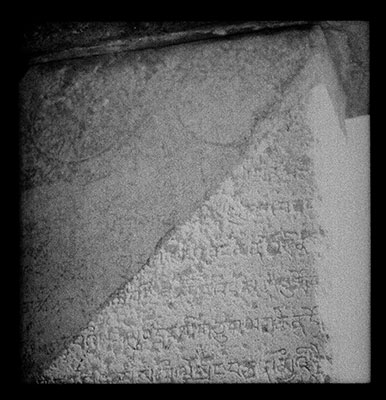
2001.59.17.69.1 (Film negative)


2001.59.17.69.1 (Film negative)

Hugh E. Richardson
Hugh Richardson
1949
Chyongye Valley Region > Chyongye
2001.59.17.69.1
55 x 55 mm
Negative film nitrate
Donated August 2001
The executors of the estate of Hugh E. Richardson
Richardson's 1949 tour of the Yarlung and Chyongye valleys
Manual Catalogues - Notes on negative album (outer case) - 'INSCRIPTIONS ON RDO RINGS' (in black ink on white label) and 'Inscriptions & misc.' (in black ink on yellow label) is written in Richardson's hand on the cover of the negative album. [KC 21/9/2006]
Manual Catalogues - Notes on negative index - '9 - 17'
Manual Catalogues - Richardson's Handlist, Negative book '9' 'Drikhung, Chongye etc.' [no] 60. ' Phyong-rgyas is in a valley south of the Brahmaputra at Rtse-thang, and west of the Yarlung valley. There is a dzong on the site of a palace of the early kings called 'Phying-ba stag-rtse; and also a monastery, Ri-bo-bde-chen, of the Dge-lugs-pa sect. East of the village in a small valley are the tombs of the kings of Tibet. See Mkhyen-brtse p.130 and G. Tucci. The Tombs of the Tibetan Kings. Rome 1950.' [KC 30/5/2006]
Other Information - History: Richardson wrote about the history and significance of this pillar in A Corpus of Early Tibetan Inscriptions, H.E. Richardson, James G. Forlong Series, no. xxix, London Royal Asiatic Society, 1985, pp. 84-91, ' Rdo-rings at the tomb of Khri Lde-srong-brtsan', "An impressive stone pillar bearing on its south face an inscription in commemoration of Khri Lde-srong-brtsan stands a little way from one of the great tumuli ( bang-so ) at the burial ground of the Tibetan kings near 'Phyong-rgyas. The mound was identified by a local monk who accompanied me as that of "Sad na legs". ... The lower part of the pillar was buried in the ground and only 21, rather damamaged lines were to be seen. After copying and photographing them I was able to have a narrow, sloping trench dug down to what appeared to be the end of the inscription; and in dark cramped conditions a companion and I copied separately, with difficulty, what could be made of a further twenty-five lines. The reward was tantalizingly small." See also, High Peaks, Pure Earth , H. E. Richardson, London, Serindia Publications, 1998, pp. 269-271 where he discusses his visit to the site in 1949 and subsequent interest in the pillar. "Now the Chinese authorities have had the whole pillar excavated and enclosed in a small building. ... it rests on a stone tortoise and has a carved decoration of snakes and dragons on its east face. It proves to be a monument of even more imposing dimensions than I had surmised. ... The pillar itself is said to be 5.6 metres in height and the monumnet overall from base to filial to be 7.18 metres. ... On the east and west faces dragons appear to pursue each other in a scattering of Chinese "cloud-heads" above a group of writing sepents. The cloud design also appears on the underside of the canopy together with flying apsaras or vidyadhara figures at each corner and the sun in the centre of the east side and the moon on the west. The sun and moon are also carved at the head of the inscription on the pillar itself." [KC 2/6/2006]
For Citation use:
The Tibet Album.
"Tride Srongtsen's inscription pillar in the Chyongye valley "
05 Dec. 2006. The Pitt Rivers Museum.
<http://tibet.prm.ox.ac.uk/photo_2001.59.17.69.1.html>.
For more information about photographic usage or to order prints, please visit the The Pitt Rivers Museum.
© The Pitt Rivers Museum